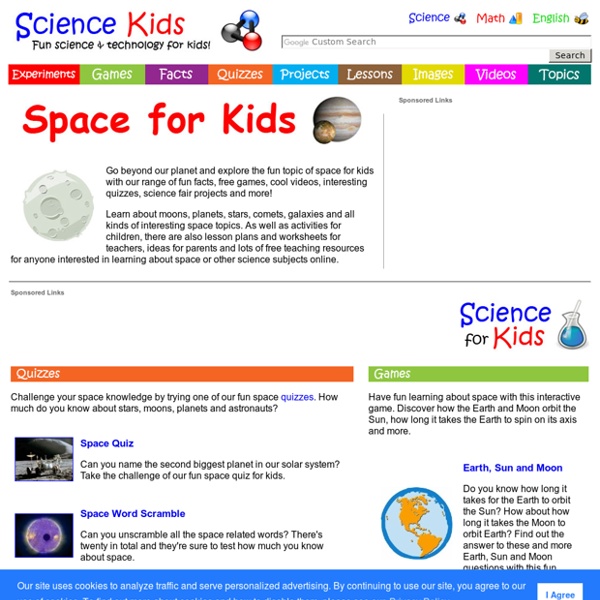Zoom
Trash
Related:



Britannica School Solar System Scope - Online Model of Solar System and Night Sky The Four Seasons Purpose To understand that it is the tilt of earth’s axis that causes the seasons. Context From their earth studies in grades 3 through 5, students have learned about earth itself and earth in relation to the sun. Students should understand that earth is on an axis and rotates (resulting in night and day) and that earth takes about a year to orbit the sun. There is a common misconception (not mentioned in Benchmarks) of people of all ages regarding the seasons, and that is the notion that earth heats up because it is nearer to the sun. Planning Ahead You will need materials to demonstrate earth orbiting the sun. Motivation The following questions will help you ascertain what your students think about how the seasons occur. What are our seasons like? Development Begin the lesson with a brief reading and activity at A Reason for the Season. Note: Tell students not to follow the "cosmic map" link at this time. After the activity, ask this question: Put a large ball on a desk. Ask students:
Astronomy For Kids - KidsAstronomy.com solarsystem.nasa There are more planets than stars in our galaxy. The current count orbiting our star: eight. The inner, rocky planets are Mercury, Venus, Earth, and Mars. NASA's newest rover — Perseverance — landed on Mars on Feb. 18, 2021. The outer planets are gas giants Jupiter and Saturn and ice giants Uranus and Neptune. Beyond Neptune, a newer class of smaller worlds called dwarf planets reign, including longtime favorite Pluto. Planets of our Solar System Mercury Mercury—the smallest planet in our solar system and closest to the Sun—is only slightly larger than Earth's Moon. Venus Venus spins slowly in the opposite direction from most planets. Earth Earth—our home planet—is the only place we know of so far that’s inhabited by living things. Mars Mars is a dusty, cold, desert world with a very thin atmosphere. Jupiter Jupiter is more than twice as massive than the other planets of our solar system combined. Saturn Uranus Neptune What is a Dwarf Planet? Real-Time, Interactive Solar System
RussianSpaceWeb.com The most stunning images of Earth ever taken from the International Space Station Indian Ocean Maldives Pacific Ocean Hawaii Aurora Australis, New Zealand East coast of Spain at Night Manam Volcano, Papua New Guinea HTV on ISS backdrop East coast of Argentina Beaver Lake in Arkansas USA East Coast of the USA, with the last light of the day visible on the horizon Earth and the stars Long Beach California night clouds United Kingdom and Ireland by night ATV launch viewed from ISS ISS solar panels French Riviera by night Barcelona, Spain by night Super Moon Cape Cod, Massachusetts Moscow, Russia by Night Sunset off West Africa Sicily, Italy Lake Qadisiyah on the Euphrates river, Iraq Heart shaped atoll north east of Solomon Islands San Quintin Glacier, Chile Crete, Greece and Turkey Nile River Buenos Aires, Argentina – Rio de la Plata Cyclone Dianne forms off the north west coast of Australia Somali Desert Chaco National Park Paraguay Parque Nacional Los Glaceres Argentina Santiago, Cabo Verde The Dead Sea, Israel Rio Sao Francisco, Brazil Sunset reflection in the Caspian Sea
Planet Facts Read some really neat facts about the planets in our solar system! © Contributed by Leanne Guenther Note: The fast facts on this page are appropriate for grades 1 to 3 while the "more about" links are appropriate for grades 4+. I've listed them in order from closest to furthest from the sun: Mercury Venus Earth Mars Ceres (dwarf planet found in the asteroid belt) Jupiter Saturn Uranus Neptune Pluto (Note: Pluto is considered a dwarf planet now) Eris, Makemake, Haumea, Sedna (also dwarf planets -- found past Pluto) Mercury takes 59 days to make a rotation but only 88 days to circle the Sun. Many astronomers believe that Mercury might be the core of what was once a much larger planet -- it appears to be a huge ball of iron covered by a thin layer of rock. Venus is the brightest planet in our sky and can sometimes be seen with the naked eye if you know where to look. Earth has more exposed water than land. On-Line Jigsaw Puzzles: Between Mars and Jupiter, is a Dwarf Planet known as Ceres.
-This game is great for learning about the earth, sun, and moon's orbits.
-It allows students to experiment with different dates and times and how that affects the orbits. It dives into the numbers of hours, and seasons and how that relates to our calendar
-This game also talks about the size of the planets and moons and their speeds, lots of fun facts that match the standards to learn!
-You can bring all students to the carpet or have them stay at their desks. Then create two teams and have Popsicle sticks to draw random names for whose turn it is to come to the smart board. After each game, teams can win points from their representative playing the game. by ajosephik Apr 26